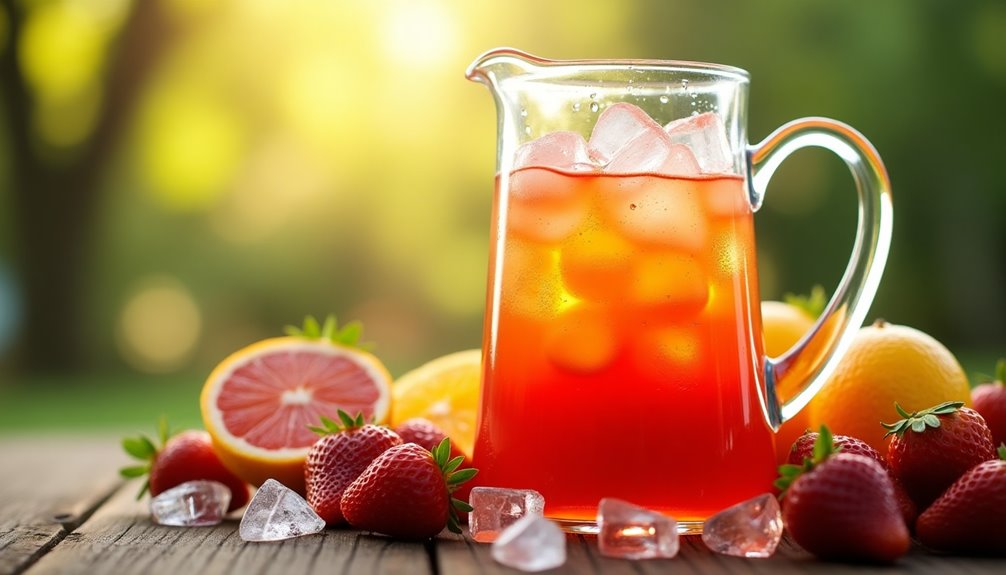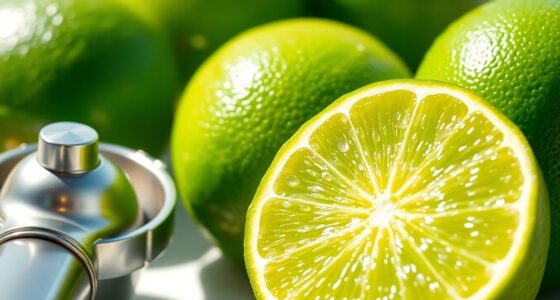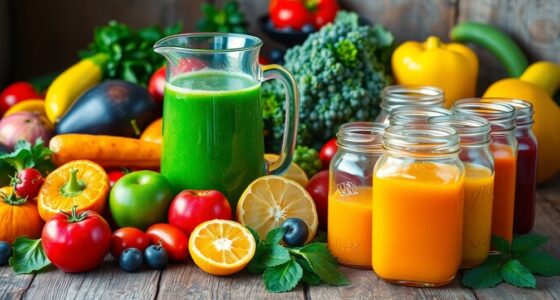Making frozen juice concentrate is quick and rewarding. Start by selecting fresh, juicy fruits like oranges or lemons. Use a hand juicer to extract every drop of juice. Pour the juice into a freezer-safe container and freeze it for 24 hours. When you're ready to use it, thaw the juice upside down, capturing excess water. You can mix it with water for juice, or use it to enhance sauces and desserts. There's much more to exploring this process!
Key Takeaways
- Choose fresh, easily juiced fruits like oranges or lemons to ensure vibrant and flavorful juice.
- Extract juice using a hand juicer, collecting every drop for maximum concentrate yield.
- Freeze the juice in a freezer-safe container for 24 hours to create a concentrate.
- Thaw the frozen juice upside down to capture excess water, monitoring until mostly clear ice remains.
- Store the concentrate in an airtight container in the freezer for several months for easy access.

Making your own frozen juice concentrate is a simple and rewarding process that enhances your beverages and culinary creations. When you decide to embark on this delicious journey, you'll find it's not only cost-effective but also allows you to control the quality of the fruit juice you're using. Plus, it opens up a world of flavor possibilities for all your favorite drinks and recipes.
To start, choose easily juiced fruits like oranges or lemons. These fruits yield a vibrant, flavorful juice that makes an excellent concentrate. You can use a hand juicer or extract the juice by hand. Just make sure you get every drop of that delicious fruit juice. Once you’ve perfected your technique with oranges and lemons, consider exploring other fruits like pomegranates for a unique twist. If you’re wondering how to juice a pomegranate, start by cutting the fruit in half and using a hand juicer or a press to extract the jewels. The resulting juice is not only rich in flavor but also packed with antioxidants, making it a fantastic addition to your collection of homemade juices.
Once you've squeezed out the juice, pour it into a freezer-safe container. It's best to freeze the juice for a full 24 hours. This will ensure you create a solid block of frozen juice that can be easily processed later.
After the juice has frozen solid, it's time to set up your thawing station. You'll need a container and a narrow funnel to catch the excess water as the frozen juice thaws. Place the funnel in the container, and then take your frozen juice out of the freezer.
Place it upside down in the funnel, allowing the juice to thaw slowly. As the ice melts, the excess water will drip away, leaving you with a concentrated form of the juice. It's essential to monitor the thawing process until the juice is mostly clear or white ice remains. This indicates that most of the water has been removed, transforming your frozen juice into a potent juice concentrate.
Once you've achieved the desired concentration, you can use it in multiple ways. To create standard juice, simply mix your juice concentrate with water. The ratio can vary depending on how strong you'd like your juice to taste, so feel free to experiment until you find the perfect balance.
Alternatively, consider using your juice concentrate as a flavoring agent in various culinary applications. It can elevate sauces, desserts, and even marinades, adding a burst of fresh fruit flavor to your dishes.
Storing your juice concentrate is easy. Just transfer it into an airtight container and keep it in the freezer. It can last for several months, giving you plenty of time to enjoy your homemade juice whenever you desire.
The next time you reach for a drink or need a flavorful ingredient, you'll appreciate the effort you put into making your own frozen juice concentrate. You'll not only have a delicious product on hand, but you'll also feel great knowing you made it yourself, tailored to your tastes.
Enjoy the satisfaction of crafting your own juice concentrate and watch as it transforms your beverages and meals into something truly special.
Frequently Asked Questions
How Do You Make Frozen Concentrate Juice?
To make frozen concentrate juice, you'll first need to extract juice from your chosen fruits. Use a hand juicer or squeeze them by hand.
Once you've got the juice, pour it into a freezer-safe container and freeze it for at least 24 hours.
After it's frozen, let it thaw slightly until only ice remains, then cut away the ice to collect the concentrated juice.
Store it in the freezer for later use in drinks or recipes!
How Do You Make Homemade Juice Concentrate?
Imagine savoring a burst of fresh fruit flavor anytime you want.
To make homemade juice concentrate, start by juicing your favorite fruits, like oranges or lemons. Freeze the juice in a container for about 24 hours.
Once solid, let it thaw in a strainer at room temperature, checking every 15 minutes. Cut away the ice cap until you're left with pure concentrated juice.
Store it in the freezer and enjoy it in various drinks or recipes!
How Much Water Do You Add to Frozen Orange Juice Concentrate?
When you're mixing frozen orange juice concentrate, a good rule of thumb is to add three parts water to one part concentrate.
For example, if you're using a standard 12-ounce can, you'll want to mix in 36 ounces, or about 4.5 cups of water.
Always check the packaging for specific instructions, as some brands might vary.
Feel free to adjust the water based on your taste; less water means a stronger flavor!
Why Did They Stop Making Frozen Juice Concentrate?
You know what they say: "Out with the old, in with the new."
Frozen juice concentrate production declined because consumers gravitated towards fresher, less processed options. The rise of convenient single-serve packs and health trends emphasizing natural ingredients made frozen concentrates less appealing.
As major brands pivoted to fresh juices and smoothies, they found it tough to compete. Ultimately, these shifts in preference led to a significant drop in the market for frozen juice concentrates.
Conclusion
In conclusion, making frozen juice concentrate is like capturing summer in a bottle, allowing you to enjoy refreshing flavors year-round. With just a few simple steps, you can transform fresh fruits into a delicious concentrate that's perfect for sipping or mixing into your favorite recipes. So, roll up your sleeves and dive into this delightful project. You'll not only savor the fruits of your labor but also impress friends and family with your homemade creation!
Cindy thoroughly researches juicing trends, techniques, and recipes to provide readers with practical advice and inspiration. Her writing style is accessible, engaging, and designed to make complex concepts easy to understand. Cindy’s dedication to promoting the advantages of juicing shines through her work, empowering readers to make positive changes in their lives through the simple act of juicing.

















